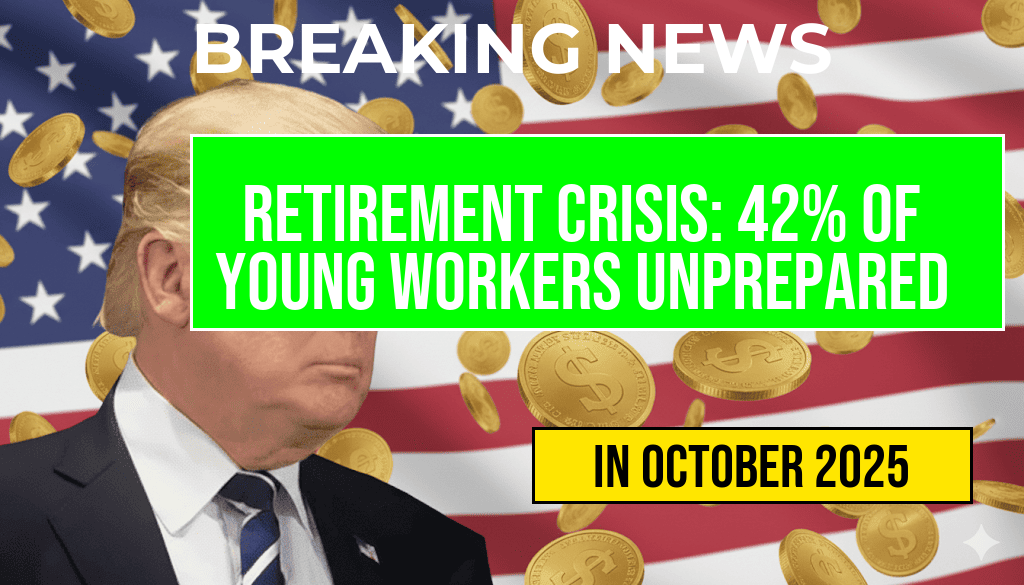Nearly half of younger American workers are facing a troubling financial reality: they have no spare cash to cover unexpected expenses or contribute meaningfully to their retirement savings. Recent surveys indicate that 42 percent of workers under age 40 report having less than $1,000 in savings, a figure that underscores a widening retirement savings crisis across the nation. As inflation persists and wages stagnate for many, this financial vortex is trapping millions in a cycle of insecurity, raising questions about the sustainability of traditional retirement planning strategies and the long-term health of the U.S. economy.
The Growing Gap in Retirement Preparedness
Data from the Federal Reserve and various financial research organizations reveal stark disparities in savings habits. Younger workers, particularly those between 25 and 39, are less equipped to handle unforeseen costs—be it medical emergencies, car repairs, or sudden job loss—compared to older generations. Despite increasing awareness of the importance of early savings, a combination of stagnant wages, rising living costs, and mounting student debt leaves many unable to prioritize retirement contributions.
Key Factors Contributing to the Crisis
- Stagnant wages: Real income growth has lagged behind inflation for over a decade, reducing disposable income.
- High debt levels: Student loans and credit card debt absorb a significant portion of monthly earnings, limiting savings capacity.
- Rising living costs: Housing, healthcare, and education expenses continue to escalate, squeezing budgets.
- Limited access to employer-sponsored plans: Many part-time or gig workers lack access to retirement accounts like 401(k)s.
Implications of Insufficient Retirement Savings
The consequences extend beyond individual financial hardship. A large segment of the workforce approaching retirement age without adequate savings could strain social safety nets, increase dependency on government programs, and hinder overall economic growth. Experts warn that this trend could lead to a surge in poverty among seniors, with many retirees forced to work well into their seventies or rely solely on Social Security benefits, which are often insufficient to cover basic needs.
Projected Outcomes if the Trend Continues
| Scenario | Impact on Retirement Security | Economic Consequences |
|---|---|---|
| Continued Low Savings Rates | Increased dependency on social programs, higher poverty rates among seniors | Greater strain on federal and state budgets, reduced consumer spending |
| Improved Financial Education & Policy Changes | Higher savings, more secure retirements, reduced poverty | Economic stability, increased consumer confidence |
Policy Responses and Potential Solutions
Addressing this crisis requires a multifaceted approach. Policymakers are exploring options such as expanding access to retirement plans for gig and part-time workers, incentivizing savings through tax benefits, and increasing financial literacy initiatives. Some states have already implemented automatic enrollment programs in employer-sponsored plans, leading to modest but meaningful increases in participation rates.
Role of Employers and Financial Institutions
Employers can play a critical role by offering flexible retirement options and matching contributions, even for part-time staff. Financial institutions are also encouraged to develop accessible, low-cost savings products tailored to younger workers struggling to set aside funds. Digital tools and mobile apps have gained popularity as means to track spending and automate savings, making it easier for individuals to build a financial cushion over time.
Breaking the Cycle: Steps for Younger Workers
While systemic change is essential, individual action remains vital. Financial advisors recommend that younger workers prioritize creating an emergency fund of at least three to six months’ worth of expenses before making substantial retirement contributions. Small, consistent savings can compound over time, especially when combined with employer matches and government incentives. Additionally, reducing non-essential expenses and increasing financial literacy can empower younger Americans to take control of their financial futures.
Resources for Financial Planning
The path toward a secure retirement for younger Americans is fraught with challenges, but strategic action—both at the policy level and individual level—can mitigate some of the risks associated with the current financial vortex. Without concerted effort, a significant portion of the workforce risks facing economic hardship in their later years, emphasizing the urgent need for innovative solutions that make financial security attainable for all.
Frequently Asked Questions
What is the current state of retirement savings among younger workers?
Many younger workers are facing a retirement savings crisis, with approximately 42 percent having no spare cash to contribute to their future retirement plans.
What factors are contributing to the lack of savings among young workers?
Contributing factors include low wages, rising living costs, debt, and a lack of financial literacy, which collectively hinder their ability to save for retirement.
How does the retirement savings crisis impact future financial security?
The lack of savings among younger workers threatens their financial security in retirement, potentially leading to increased reliance on social programs and personal debt later in life.
What measures can young workers take to improve their retirement readiness?
Young workers should consider starting early with regular contributions, utilizing employer-sponsored plans like 401(k)s, and improving their financial literacy to make informed decisions.
What role do employers and policymakers play in addressing the retirement savings crisis?
Employers can offer more accessible retirement plans and financial education, while policymakers can implement incentives and regulations to encourage retirement savings among younger populations.






